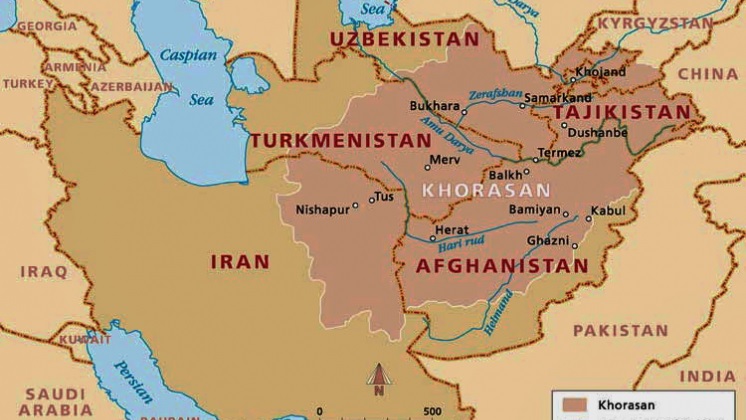Khorasan at a Glance
Prior to the formation of the state of ‘Afghanistan’ in the late 19th century, the Northern territories of present day Afghanistan (see map below) belonged to a land known as Khorasan (خراسان), meaning “Land of the Rising Sun”. Khorasan was a multiethnic land in which various indigenous nations – mostly Iranian (e.g. Tajiks and Pashtun) and Turkic (e.g. Uzbek, Hazara, Turkmen) – lived side by side (1, 2).

In the late 19th century, the state of Afghanistan – incorporating the southeastern lands of Khorasan – was created as a buffer zone between expansionist Russia and colonial India (3). Before this time, the term ‘Aughan’ or ‘Afghan’ (Arabized) was only used to refer to Pashtuns – a nation indigenous to the south/southeastern provinces of present day Afghanistan and western Pakistan. The new state of Afghanistan, supported by the British, was highly centralized and Pashtun dominated and aimed to marginalize the non-Pashtun nations of Afghanistan with the aim to secure power and control of their territories.
Since then, Afghanistan has been led by a Pashtun dominant government, with only a few exceptions of Tajik rulers: the reign of Kalakani for a few months in 1929, the government of Babrak Karmal (1979-1986)* and the government-in-exile of Rabbani (1996-2001) (2, 3). Multiple ethnic genocides have taken place in Afghanistan since the creation of the state. For instance, during his rule, Amir Abdur Rahman Khan (1880-1991) committed a genocide against the Hazara nation of Afghanistan by waging a war against them, forcefully resettling Pashtuns in their indigenous lands, and forcefully displacing them (4). Although the genocide against Hazaras has been most pronounced, the state of Afghanistan has also conducted ethnic cleansing against other ethnic groups of Afghanistan including Tajiks (5), for instance against the people of Shamali living in Kabul during the previous and current Taliban regime. Unfortunately, these genocides have never been formally recognized.
Some non-Pashtuns in Afghanistan, including some Tajiks, do not identify themselves as Afghans – which is often, but not always, seen as being synonymous with the term ‘Pashtun’ – and refer to themselves by their ethnic group (3). These groups see the term ‘Afghanistan’ as referring to the “Land of the Pashtuns”, and criticize it for marginalizing the other ethnic groups of Afghanistan which make up at least 60% of the country’s population. Some activists advocate for changing the name of the country from ‘Afghanistan’ into one that is less ethnocentric, such as Khorasan.
*The ethnicity of Babrak Karmal has actually been disputed. He himself claimed to be Pashtun, but evidence suggests that he was a Persian – Tajik or Qizilbash (6). Some believe he only made the claim of being Pashtun as a way to shield himself from the criticism of the Pashtun elite – which had had a hegemony of power in Afghanistan for centuries.
Prior to the formation of the state of ‘Afghanistan’ in the late 19th century, the Northern territories of present day Afghanistan
FOLLOW US ON SOCIAL MEDIA